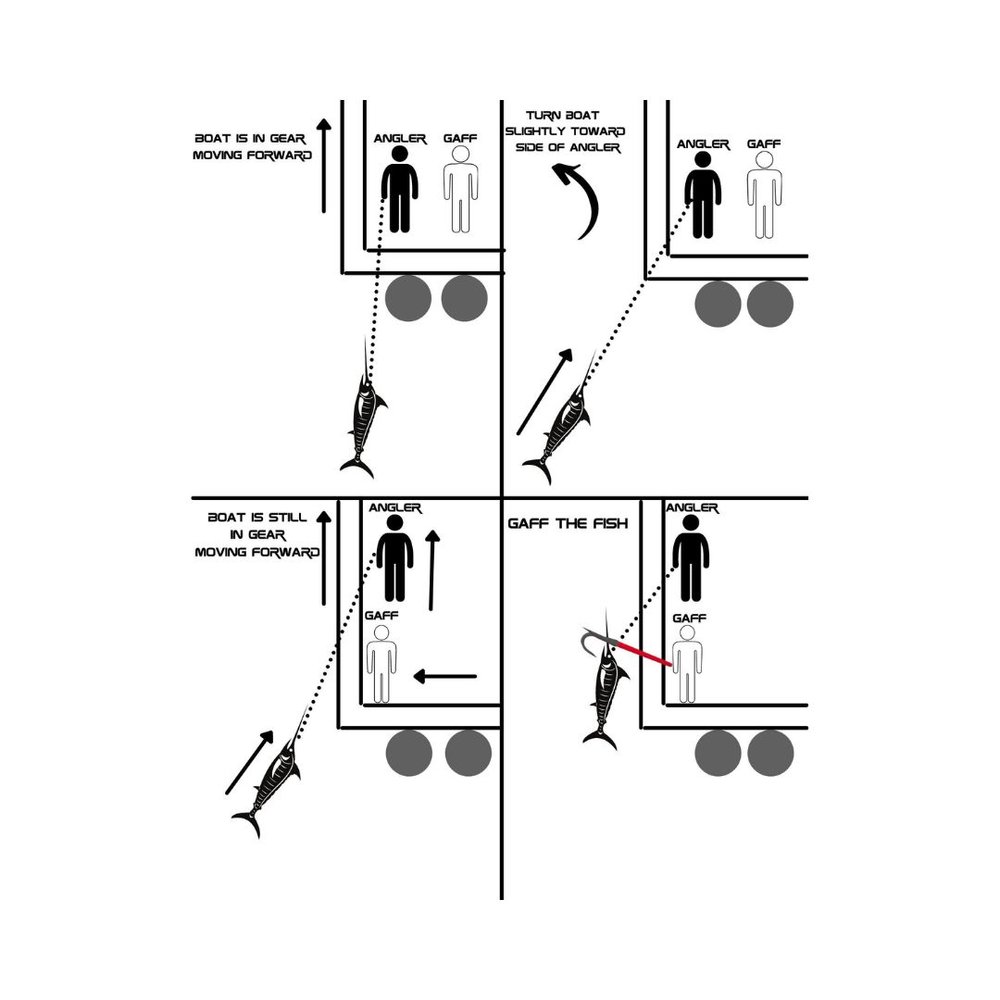One of your lures gets absolutely smashed by a Mahi-Mahi, it is the first pelagic species to hit your line, and you yell some choice words and scramble around trying to figure out what to do first. Whatever you do, do not pull the boat out of gear. Keep the boat pointed straight, doing 6-7 knots, and bring in the other three lines. At this point, line is probably coming off the reel that the Mahi is on at a quick rate and many anglers are tempted to ratchet the drag up, do not touch the drag unless you are at risk of getting spooled in the next 20 seconds. You should have at least 500 yards of line to work with, so just let the fish run if it is going to run. We once had an inexperienced crew member on our boat and we hooked a yellowfin tuna, the crew member grabbed the rod and proceeded to smash the drag lever to max. the rod tip bent forward and then pop! the line broke. There was still 400 yards of line left on the reel and we lost a nice fish.
Once all the lines are brought in, you can pull the throttles back a little bit, but always keep the boat in gear headed away from the fish unless your angler cannot gain line back on the reel. This allows you to keep tension on the line with the boat at all times and mitigate any ‘bow’ the line might have while your angler is fighting the fish. If the fish is big enough that you cannot gain line back on the reel, then you can start to turn and ease at an angle towards the fish to help your angler get line back. This is only necessary for the biggest of fish that would hit your lures. Most average Mahi, Wahoo, and Tuna will be subdued by just keeping the boat in gear, line tight, and letting your angler work the fish in.
At this point in the fight is when you can tighten the drag depending on the fish’s size and how long you have been fighting the fish. There are no set rules on when to tighten the drag, but we will tighten it a couple pounds in the beginning of the fight if we are not really gaining any line back and then slowly keep bumping it up until we feel that we are putting enough pressure on the fish to win over time. If it is truly a big fish you may be fighting it for 1-2+ hours. When we hooked a giant Bluefin Tuna, we initially started with 15 pounds of drag when it hit, bumped it up to 20 pounds 30 minutes into the fight since we knew it was a giant, and then continually moved it up over the next two hours until we maxed out our drag at 32#. The fish ended up dying on the line and it took us a little under 5 hours to get it to the boat. Be patient with bigger fish and keep pressure on them but know that it will be a back-and-forth game of take an inch-lose-a-foot until the big fish starts tiring at the end of the fight.
The End Game
When coming to the end of the fight, the first thing you want to do is make sure that the angler knows which side of the boat you are going to gaff the fish on. When that has been established, the driver of the boat needs to make sure that they keep the angler towards that side using the throttles. The angler should not have to move around the boat, the boat should move around the fish. That is worth repeating, do not have your angler running circles around your boat following the fish, you should be keeping the boat in gear and turning to ensure that the angler stays on one side of the boat. If the fish does make a drastic run for another side the angler can move to that side in a quick instance, but the boat driver should be vigilant and keep the fish on one side.
At this point the fish should be somewhere behind the boat, the angler is staying towards one side of the boat, the gaffs are out, and the driver is watching to see where the fish is. When the fish starts getting closer, the driver will slightly turn the boat at an angle towards the side of the boat that the angler is on. That way the fish will be at an angle to that side of the boat and not be coming in by the engines. See the image below for illustration of this process.

Once the boat has been turned and the fish is getting within 10 yards of the transom, the angler will start to walk up the side of the boat and the gaff man will take the angler’s spot on the back of the boat. The fish at this point should be coming up the side of the boat and getting close enough for the gaff man to stick the gaff into the fish. Once the fish is in the boat, turn the boat back towards where you got the bite and put those lines back out to get another one!
